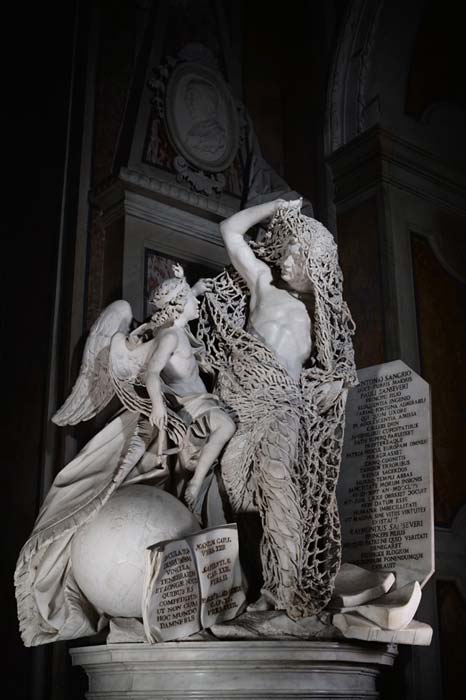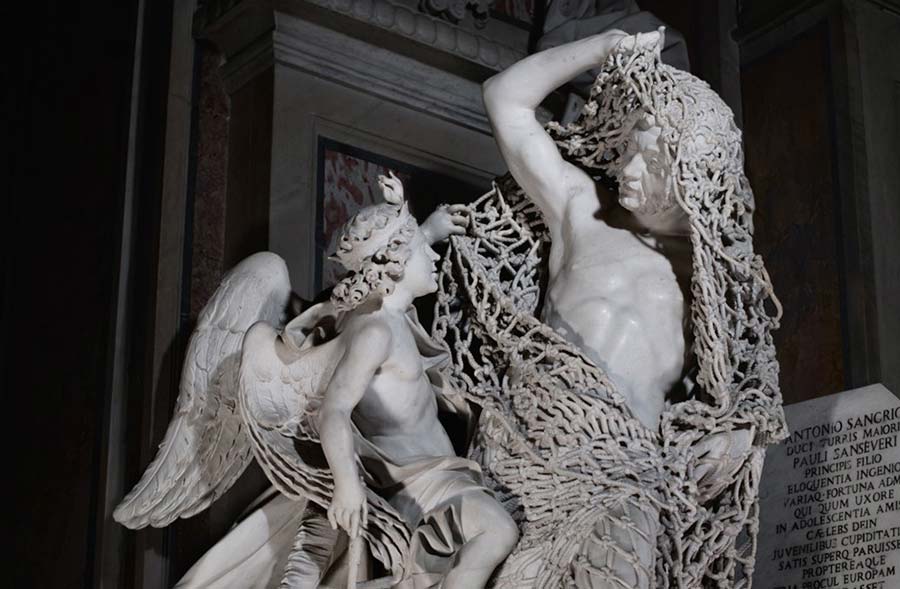The Impossible Statue: The Marvelous Marble Net of Il Disinganno
The impossible sculptural feats within the Sansevero Chapel Museum in Naples will take your breath away. Amongst them, the famed statue known as Il Disinganno, was carved out of one single block of marble. But, who created it and why?
The Mysteries of Marble and its Use by Ancient Sculptors
Since ancient times people have impressed their imaginations into wood and stone using a range of tools crafted from the same two substances. Soapstone and alabaster are the softest stones to carve, while granite and marble represent the hardest, and this is why in history these two substrates were only ever carved by the very best time-served sculptors.
Composed primarily of recrystallized calcite or dolomite, marble is a metamorphic rock, meaning it was once sedimentary limestone that changed (metamorphosed) as a result of intense geological heat or pressure. The process of metamorphism does not melt rocks, but it transforms them into denser, more compact rocks.
Through this process marble is formed with medium-grained Interlocking crystals with no alignment and what this means is that every stonemason’s chip brings with it a high degree of unpredictability. This is why only master stonemasons ever worked with marble.
- Looted Ancient Roman Bust Found In Texas Thrift Shop
- Why is Social Media Afraid of the Naked Truth in Art?
Ancient sculptors were trained in selecting raw materials, carving, modelling, casting and polishing, but the most renowned artisans also had instincts for replicating the motions of anatomy and drapery. Carved in Attica in Greece, one of the oldest marble sculptures in the world is a statue of a kouros (youth) which was crafted between 590 and 580 BC and was used to mark the grave of a young Athenian aristocrat.

Found in Attica, this funerary marble statue of a kouros, is one of the oldest marble sculptures to have been discovered. (Public domain)
Il Disinganno: Exquisite Sculpture at Sansevero Chapel in Naples
Besides its geological strength, one of the primary reasons marble was so highly valued is because it absorbs light into its surface and refracts it back into the subsurface scattering. This is the reason for why marble sculptures have a ghostly glow when polished correctly.
A visit to the Sansevero Chapel Museum in Naples, Italy, is truly a treat for anyone who loves sculpture. The chapel is actually a burial site for the family of John Francesco di Sangro who built it in the 16th century. The family commissioned sculptors of their era to create sculpted tributes to their ancestors. This is the reason for why the site is home to so many stunning artworks.
Sansevero is home to three sculptural masterpieces. These are The Veiled Christ by Giuseppe Sanmartino, created in 1753, The Veiled Truth by Antonio Corradini, created in 1750, and The Release from Deception by the Genoese artist Francesco Queirolo, completed in 1754.

Court of marble sculptures at the Sansevero Chapel Museum in Naples. (David Sivyer / CC BY-SA 2.0)
Symbolic Interpretation of Il Disinganno
The Release from Deception, actually called Il Disinganno in Italian and often translated as Disillusion, can be found within the royal court of ancient marble sculptures at Sansevero Chapel Museum. This statue was commissioned by the Italian nobleman Raimondo di Sangro in honor of his father, Antonio di Sangro, the Duke of Torremaggiore. This particular marble statue is famed because of its exquisitely carved fishing net. It depicts an angel standing on a globe as he frees a fisherman who has been entrapped in his net. At his feet is a Bible.
According to My Modern MET, the symbols in Il Disinganno are thought to have been inspired by sculptor Raimondo’s dedication to his father which explores the idea of “human fragility, which cannot know great virtues without vice.” Nevertheless, visitors of a secular persuasion read this sculpture differently, for example, the globe can signify worldly passions and the flame on the angel's head might represent human intellect or consciousness.
Il Disinganno de Francesco Queirolo (1759). Esta estatua también está esculpida totalmente en mármol, incluida esa red. Impresionante. pic.twitter.com/2yWf8fd7KR
— Miguel García (@Milhaud) April 3, 2018
However, My Modern Met also explained that Christian’s read the net within Il Disinganno as symbolizing sin, from which the angel is freeing the fisherman by introducing him to the Bible. The good book included within the statue is open at a page reading “I will break thy chain, the chain of the darkness and long night of which thou art a slave so that thou might not be condemned with this world.”
According to the Sansevero Chapel Museum in Naples, Il Disinganno also denotes “aspects of freemasonry,” but this is only because freemasonry leans heavily on the Bible which is referred to as the “Book of the Law” and one of the “three great lights” of Masonry along with the architect's square and compass, claims Novus Veteris.
Interpreting the symbolic content within The Release from Deception is a road frequently travelled, but what is less often discussed is that this piece displays some of the finest examples of the stonemason’s craft in existence. This is especially true of the intricate fisherman’s knotted net which was flawlessly relieved from one solid block of marble. Over the last 250 years Queirolo's marble netting has been regarded as one of the finest pieces of stonemasonry ever created and 20th-century Italian novelist Matilde Serao described Il Disinganno as “a singular closure of life, a singular term for all sublimities, all passions, all loves.”

Il Disinganno, or The Release from Deception, by the Genoese artist Francesco Queirolo. (Dalia Nera / CC BY-NC-SA 2.0)
Freeing Forms Trapped Within Blocks: The Pressure of Working in Marble
The Renaissance artist Michelangelo di Lodovico Buonarroti Simoni (1475 to 1564) said his job was “to free the human form trapped inside the block.” After thousands of years of trial and error, by the 18th century stonemasons had developed a set of marble carving tools including the tooth chisel, the point chisel and the drill and rasp.
However, even with these tools and decades of training, with every chip the mason took away from the marble block the working pressure increased, for one miscalculation might ruin an entire sculpture after several years of hard work. To add to the stress of working in marble, marble can be discolored by oils in the craftsman skin and acid rain and acidic environments can also degrade marble.
Once a block of raw unhewn marble had been selected, masons began by pitching it. This required splitting off large unwanted parts of the rock using a wooden mallet and point chisel. This long piece of steel was pointed at one end with a wide striking surface at the other, and working around the block of marble with the delicacy and rhythm observed in musicians, sculptors formed the rough shape of their figure.
Then, a toothed chisel was applied to add texture to the surface of the rock, before rasps were swept across the stone removing small chips and smoothing imperfections. In the polishing phase sculptors used various sand and emery papers to bring their works into high resolution and to create the otherworldly sheen emitted by marble statues.
- No Average Artists: Who Was Deemed Good Enough to Create Sculptures of Alexander the Great?
- Unrivalled Classical Art: Giovanni Strazza's Exquisite Veiled Virgin
Having mastered the tools, the skills and the environment, Francesco Queirolo had to summon two last qualities before he began: boldness and bravery. “Even the most specialized sculptors refused to touch the delicate net in case it broke into pieces in their hands,” explains the Sansevero Chapel Museum website. Due to all of the complexities associated with sculpting in marble, Queirolo took seven whole years to execute the net. Considering that the artist had “never had a workshop or an apprentice,” or any other form of professional assistance, this is truly a miraculous achievement.
Top image: Il Disinganno, or The Release from Deception, by the Genoese artist Francesco Queirolo. Source: Dalia Nera / CC BY-NC-SA 2.0
By Ashley Cowie
References
Museo Capella Sansevero. No date. “Disillusion – Francesco Queirolo, 1753-54” in Museo Capella Sansevero. Available at: https://www.museosansevero.it/en/Disillusion/
Novus Freemason. 2018. “The Three Great Lights of Masonry: The Book of the Law, Square and Compasses” in Novus Veteris. Available at: https://novusfreemason.org/2018/07/14/the-three-great-lights-of-masonry-the-book-of-the-law-square-and-compasses/
Richman-Abdou, K. 17 March 2019. “18th-Century Sculpture Has a Delicate Net Carved Out of a Single Block of Marble” in My Modern MET. Available at: https://mymodernmet.com/francesco-queirolo-the-release-from-deception/
United States Government Science. “What are metamorphic rocks?” in USGS. Available at: https://www.usgs.gov/faqs/what-are-metamorphic-rocks




















Comments
Lest anyone be confused in today’s world, THIS is art.
I find this very hard to believe.
Marvelous doesn't begin to describe the accomplishment of this sculpture. This very slow and exacting subtractive only type of sculpture means you can't add to, or fix the smallest blemish. To reproduce a fishing net !?!. WOW A lifetime achievement of Francesco Queirolo. It is a little hard to believe he did this on his first try. But it makes the storyline better, lol. Stranger things have happened! It's also wonderful that it has survived intact! Truly a blessing to just see even pictures of it.
I also liked the embedded video, particularly the bow drill use. Good job Ashley Cowie!